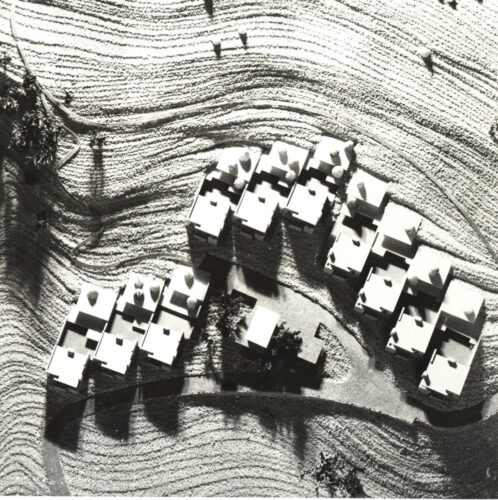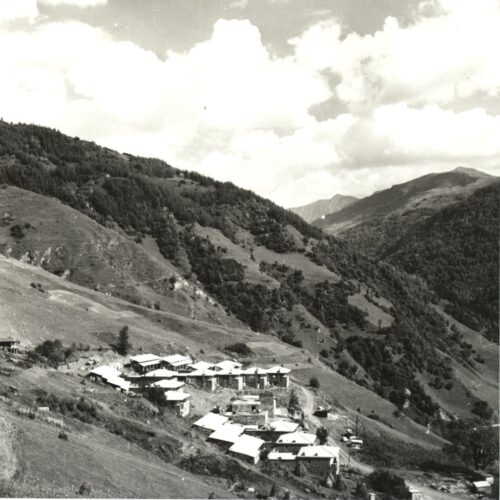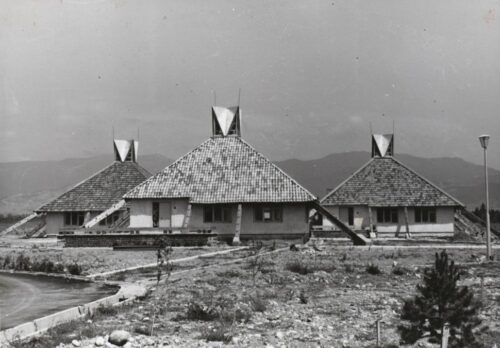სოფლის განვითარების პროექტები
Architects Irakli Margishvili, Lili Mchedlishvili, David Morbedadze, Nugzar Dvali – “SakSoplMshenSakhProekti”
Design 1970s Construction 1970-1980s
Status built
Original function residential and public buildings
Current function same
Current condition Modified, partially abandoned
Location
Cheremi, Gurjaani Municipality, Kakheti region Google Maps
Gudani, Dusheti Municipality, Mtskheta-Mtianeti Region (Khevsureti Community) Google Maps
Shatili, Dusheti Municipality, Mtskheta-Mtianeti Region (Khevsureti Community) Google Maps
Mejvriskhevi, Gori Municipality, Kartli region Google Maps
Regional characteristics – such as climatic conditions, economic development, daily habits of the population, social and demographic features, local building materials and traditions that have been established over the history – have always played a crucial role for Irakli Margishvili, throughout his extensive work on the rural development projects in Georgia.
The resettlement system of the Soviet government, which intended the socio-economic transformation of villages, demanded solving different issues around urban planning, architectural, engineering and sanitary issues. The implementation of regional urban planning took place in years 1950-1960s. Out of the historical villages, those where considered as “prospective” which were larger, had developed road and transport infrastructure and cultural and public institutions.
Development of such villages and increasing the population there had to be at the expense of resettlement from the less or “non-prospective” regions, which included villages that were located far away from central and industrialized agricultural facilities. Such planning has resulted in the emptying of the highland regions, which is an unsolved problem even today.
In 1969 the resolution of the Soviet government was published, which offered new plans about the construction of villages and obliged republic governments to start planning works for the next five years. It seems that this resolution was the basis for the implementation of several interesting and important “experimental” projects in Georgia, such as Gudani and Shatili in Khevsureti, Cheremi in Kakheti and others.
Cheremi
One of the villages affected by this resettlement process was historical village Cheremi, located on the Gombori Ridge, 1000 meters above sea level. Here are the remains of Cheremi city, founded by the king of Iberia Vakhtang I Gorgasali, necropolis and other important monuments. The population of Cheremi was resettled to valley in Gamarjveba village, Gardabani district by force in 1950s. In 1970s started the process of forming and constructing a new center in Cheremi, which included development of Central Square, public, educational and residential buildings (Irakli Margishvili, David Morbedadze, Lili Mchedlishvili, Tengiz Kvertskhishvili, Zurab Ghonghadze). In 1978-1980 the population was able to move back to their home village, but for the next three decades because of different reasons the village emptied again.
Gudani
Gudani is a village in Khevsureti, 1729 meters above sea level. Near the village is one of the most important shrines of Khevsurian people – Gudani Cross. Groups of houses with three and four units, built by the project of Irakli Margishvili, David Morbedadze and Lali Mchedlishvili, are following terrain. Residential and agricultural areas of the built-up roofed dwellings are located on different levels of the slope terrain. On a lower level there is two-story residential part, second floor of which has a partly open courtyard. On the third level there is a cowshed with hay storage on a roof. This project won an award on the International Biennale of Architecture (INTERARCH-85) in Sofia, Bulgaria, 1985.
Shatili
Shatili is historical fortress village located on the northern slope of the main ridge of the Caucasus Mountains, in the Upper Khevsureti, 1400 meters above sea level and dates back to the XVII-XVIII centuries. Shatili is in the UNESCO Cultural Heritage Tentative List. New project of Irakli Margishvili, Lili Mchedlishvili and Nugzar Dvali is implemented outside the historical fortress village. They considered native habits and used local building materials. Stone dwellings are built right side by side and each of them has three rooms, an agricultural space and a cowshed behind the building.
Mejvriskhevi
Poultry factory experimental settlement project in the village Mejvriskhevi is completely distinctive. Village is built on a flat terrain and along the straight streets single-family houses are constructed. Spaces between the streets are used for small private gardens.
Kindergarten is located at the end of the settled area. It consists of four buildings which are connected to each other by corridors. One of them is for offices. Three others are square-shaped groop rooms whith high, tent-like roofs. Rooftops have glazed turrets that provide light to the children’s play area. (ntch)
Tanslation: Ana Kiasashvili
Photos: Irakli Margishvili personal Archive


















